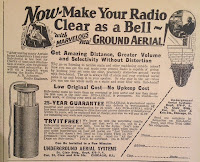 The year is 1925, one year prior to the launch of Hugo Gernsback's first issue of Amazing Stories. This was the magazine that, along with Gernsback, would later be credited for the invention of scientifiction- science fiction but not as we know it... It is for his contribution to SF that Gernsback is now remembered, the Worldcon Hugo Awards are named in his honour. But, as a former electrical engineer, his first interest was actually amateur radio. 1925 was the year he launched WRNY, an AM radio station that operated in New York and ran until 1934.
The year is 1925, one year prior to the launch of Hugo Gernsback's first issue of Amazing Stories. This was the magazine that, along with Gernsback, would later be credited for the invention of scientifiction- science fiction but not as we know it... It is for his contribution to SF that Gernsback is now remembered, the Worldcon Hugo Awards are named in his honour. But, as a former electrical engineer, his first interest was actually amateur radio. 1925 was the year he launched WRNY, an AM radio station that operated in New York and ran until 1934.
Throughout the first half of the 20th century amateur radio was a widespread hobby. In 1912 Gernsback said that he estimated 400,000 people in the U.S. were transmitting or picking up radio signals, and it was presumably audience demand that led to the establishment of WRNY. The first broadcast was on 12 June, 1925 and was covered by The New York Times. The programme included an address from the radio pioneer Lee de Forest and two hours of live musical entertainment. In those early days the idea was that anyone could build their own radio and start picking up frequencies and there were so many stations, it wasn't unusual for them to share the same frequency at different times during the day.
The prevalence of small ads. in contemporary magazines and other Gernsback publications, including Amazing Stories and Wonder Stories, testifies to the popularity of amateur radio. However, Gernsback was also a notorious self-promoter and often used his publications to cross-market one another; some titles would carry the radio station’s call letters on the cover and his company, Experimenter Publishing, produced several specialised publications for radio. In the adverts, amateur radio enthusiasts were called fans and frequently petitioned to buy the latest manuals, which covered such mind-boggling topics as 'radiotics' and 'broadcastatics'.
Still, amateur radio wasn't the only pursuit vying for the attention of the discerning reader- magic sets, night classes, exercise programmes and thinly veiled appeals to enlist for the Navy were among the other adverts. These build up a detailed, if slightly off-putting, picture of the contemporary SF enthusiast: male, possibly lonely and lacking in confidence, with an interest in all things technical and/or magical. Even during this early phase, the stage was being set for the familiar geek-sterotypes, although the later professionalisation of radio would lead to the emergence of an even more unsavoury character... the DJ.
Through his publishing actvities, Gernsback had a significant influence on the growth of early broadcasting. So, while perhaps a more modest achievement than Father of SF, his shortlived ascendancy over the airwaves is nevertheless an interesting footnote in SF's history.



No comments:
Post a Comment